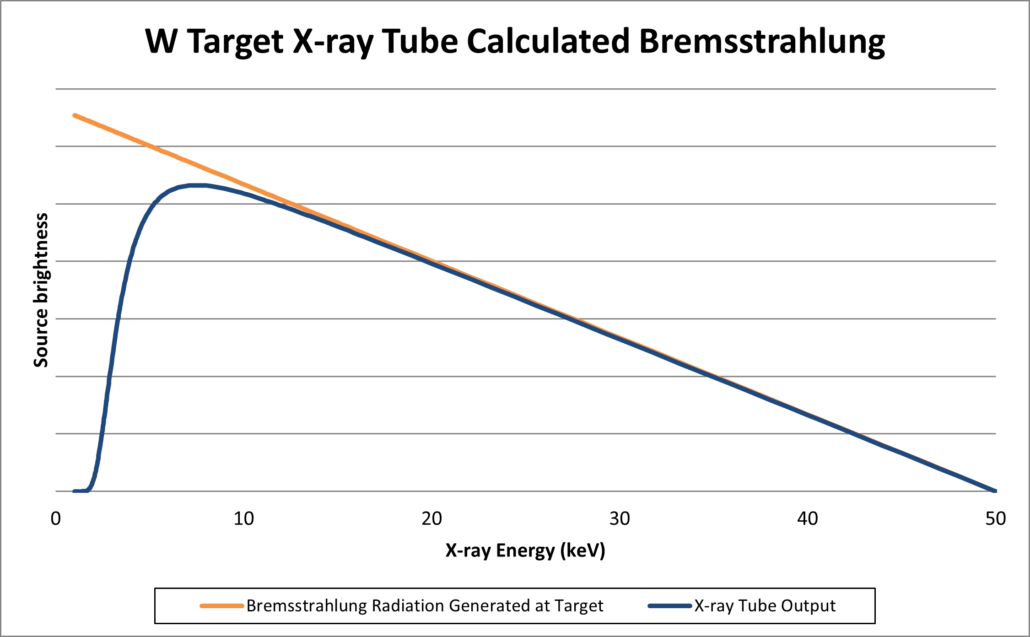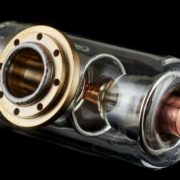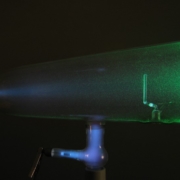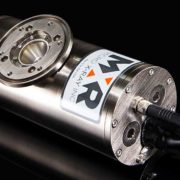X-ray Sources 101: Bremsstrahlung Radiation and Why it Matters for Imaging
We’ve talked before about choosing a target material, what a spectrum looks like, and why it matters for analytical applications. Many imaging applications overlook the importance of their tube’s spectrum and how it impacts image contrast and quality. Today we’re going to look specifically at bremsstrahlung radiation, learn what it is and why it matters in X-ray imaging.
Physics of Bremsstrahlung Radiation
Bremsstrahlung radiation, also known as “braking radiation,” is a type of electromagnetic radiation produced by the deceleration of charged particles, such as electrons, when they pass through the electric field of an atom in an X-ray tube’s target. In X-ray tubes, the charged particles, or electrons, are accelerated by a high voltage, usually in the range of 20 to 150 kV, and then collide with a target material, such as tungsten. These collisions result in the deceleration of the electrons, and the energy lost by the electrons is emitted as Bremsstrahlung radiation.
Briefly, Bremsstrahlung is different than characteristic radiation which is produced when one of the same electrons knocks an electron from an inner shell out of orbit. An electron from a higher shell jumps down to fill the gap, and the difference in energy between the shells is emitted as an X-ray. The energy of that X-ray is equal to the energy difference between the two shells.
The energy of the Bremsstrahlung radiation is directly related to the energy of the electrons, as well as the atomic number of the target material. The higher the energy of the electrons, the higher the energy of the emitted Bremsstrahlung radiation. Similarly, the higher the atomic number of the target material, the higher overall count rate of the emitted Bremsstrahlung radiation.
X-ray Imaging
Bremsstrahlung radiation is significant in X-ray imaging because it is the primary source of X-rays in X-ray tubes. The X-rays produced by Bremsstrahlung radiation are favorable for imaging purposes because they have a broad spectrum of energies, allowing for higher contrast images in materials with varying densities. This broad spectrum of energies is due to the fact that the electrons that produce the X-rays lose different amounts of energy as they pass through the target material, resulting in a wide range of X-ray energies.
The upper limit of the X-ray tube’s energy output is set by the excitation voltage of the source, and the lower limit is set by the inherent filtration of the tube, in the example below we see both the Bremsstrahlung generated at the target face, along with the output of the X-ray tube with the 254μm Be window’s inherent filtration taken into consideration.

The voltage applied to the X-ray tube and the choice of additional filtering materials are carefully chosen to produce X-rays with the desired energy spectrum for a given imaging sample. Often in imaging applications, the characteristic lines of the target material are filtered out to ensure a clean Bremsstrahlung radiation pattern for optimal imaging of the widest possible array of samples.
Summary
Bremsstrahlung radiation is a type of electromagnetic radiation produced by the deceleration of charged particles, such as electrons, when they pass through the electric field of a heavy atom in an X-ray tube. It is the primary source of X-rays in X-ray tubes and plays a crucial role in X-ray imaging. By understanding the generation and properties of Bremsstrahlung radiation, we can better understand the workings of X-ray tubes and their applications in medical and industrial imaging.
If you have any questions about target materials, imaging applications, or X-rays in general, don’t hesitate to reach out to us today!

 2020 Micro X-Ray
2020 Micro X-Ray







